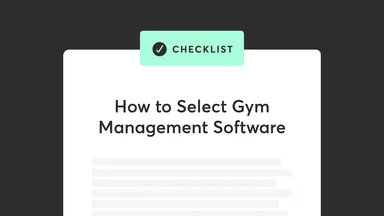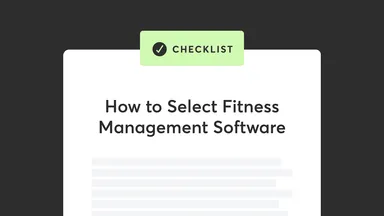Embarking on a fitness venture is an exciting endeavor. Not only does it allow you to pursue your passion for health and fitness, but it also allows you to make a positive impact on the lives of others. Like starting any business, it's a lot of hard work and requires careful planning and execution.
If you're unsure how to start your fitness business, you've come to the right place. We're here to share some foundational steps to help you through the process. You'll need to:
- Find your niche
- Do your research
- Develop a solid business plan
- Find the perfect location
- Build your brand
- Secure funding/financing
- Equip your space
- Build a strong team
- Find the right fitness management software
- Create a marketing plan
Find your niche
If you plan to open a gym or studio, it's essential to identify your fitness niche to create a personalized experience for your target audience. This involves understanding your potential clients' demographics, preferences, and fitness goals. By defining your niche, you can shape your overall approach and customize your offerings to meet your target audience's needs and interests. Some valuable tips to help you find your fitness niche include:
- Perform a self-assessment to identify the fitness modalities that you are passionate about and have experience in. Consider whether you are enthusiastic about yoga or have multiple years of Pilates experience. Reflect on which fitness genre brings you the most joy and sparks your interest in sharing it with others.
- Research what modalities are lacking in the area. For example, if there aren’t many personal training or CrossFit gyms, you may have an opportunity to provide those to the community.
- Gather local feedback from friends, colleagues, and community members to gain more perspectives on what best suits people's needs and preferences.
Nick Mitchell, the founder of Ultimate Performance, emphasizes the significance of having a unique selling point when launching a new fitness business in a highly competitive industry. "When I launched Ultimate Performance, I wanted to build a personal training space where results matter. Where clients could genuinely see a return on their investment.
For example, my trainers are only promoted based on the results they deliver, not their session numbers, so they are incentivized to deliver the best possible result for their clients. That’s our USP, and that’s why we’re the most successful personal training business in the world."
Do your research
Once you have identified your niche, comprehensive market research is essential to understanding your target demographic, evaluating competitors, and identifying potential gaps in the market. This process involves conducting surveys and interviews and analyzing industry trends to gain insights into consumer needs, preferences, and market demand.
Collecting market research will help you make better-informed decisions regarding your business's operational hours, amenities, marketing tactics, pricing, startup expenses, and ongoing costs, including rent, staffing, insurance, maintenance, equipment, and utilities. This data will provide visibility into your costs and enable you to plan accordingly.
Name your price
Pricing is essential in starting a fitness studio, so you must identify the best pricing structure for your services. Consider factors like your target market, the value you'll provide, industry standards, and your overall business goals to price effectively. As you price your services, some things to consider are:
- The market rates within your area
- Your operating costs, such as rent, equipment, insurance, utilities, and staff wages
- Your level of expertise and experience. For example, if you're an expert in your field and bring unique value to your services and business, you can factor that into your pricing
- Offering various pricing tiers, such as single sessions, weekly or monthly packages, or discounted rates for annual contracts
As you determine your prices, don't underestimate the power of a well-crafted intro offer. It will attract new clients and increase the chances they'll stick around. There are various intro offer options—including some you should avoid.
Develop a solid business plan
Your business plan is the foundation of your fitness business. Putting it all down on "paper"—your business goals, target market, pricing structure, marketing strategies and financial projections—will help you make informed decisions and secure funding if needed. At this point, you'll also want to consider the right legal structure for your business. A good business plan should consist of:
- An executive summary that provides an overview of your business
- A company description and market analysis that details what problems you plan to solve, your ideal clientele, and your competitive advantage
- An overview of your organization and management, including the legal structure of your business and staffing plans
- A detailed description of your services
- An overview of your marketing and sales strategy to attract and retain clients
- An outline of how you plan to fund your business and financial projections over the next five years
Find the perfect location
The location of your fitness business can significantly impact its success. Look for a space that is easily accessible to your target demographic and offers ample parking or public transportation options. Consider factors such as visibility, foot traffic, and competition when selecting a location for your gym or studio.
Build your brand
This part is fun but challenging. Choosing a name for your fitness business and creating your brand are essential steps. Remember, this will help set your business apart from the competition and showcase your business's personality. You'll need to decide what you want to be called, how you'll engage with your customers (digitally and in person), and how you want to look.
One critical aspect of your overall brand is your visual brand identity. These elements will appear online, on marketing materials, inside your physical space, and on branded swag:
- Logo
- Color palette
- Typography
- Photography
Use our guide to help you figure out how to create a brand.
Secure funding/financing
Financing a new small business can be challenging. Take the time to explore various financing options, such as grants, small business loans, crowdfunding, or investments from private investors. During this process, you'll present your business plan and financial projections to lenders or investors to demonstrate your venture's viability and potential return on investment.
Some business owners self-finance their gym or studio and/or take personal loans from friends and family to help get established. Others turn to small business loans. Whatever you decide, a clear financial plan will help you manage your resources effectively.
Equip your space
Behind every great fitness facility is a well-thought-out space. This includes equipment and amenities based on your chosen niche—purchase or lease fitness equipment, flooring, mirrors, sound systems, and other essentials. The goal is to create a functional and inviting atmosphere that reflects your brand and provides a positive experience for your clients.
Build a strong team
Finding and retaining good help is challenging—but critical to the success of your business. To build your team, define each role and its requirements and qualifications. Create detailed job descriptions for personal trainers, group fitness instructors, and front desk staff.
Hire qualified individuals who share your business values and have the necessary expertise. Provide good training to give your employees the skills, knowledge, and confidence to serve your clients well. A clear onboarding plan will help new hires understand your business, fitness management software, and expectations.
Doing so ensures they know how their role and responsibilities impact the big picture. The onboarding period can take place over a few days, weeks, or even up to a few months. Taking things slow will save you and your employees time in the future.
For more, download a copy of The Complete Guide to Staffing.
Find the right fitness management software
From streamlining business operations to simplifying the booking process for your clients, choosing the right software will enable you to spend less time doing repetitive tasks and more time delivering high-quality experiences to your community.
There are many factors to consider when selecting a platform, so take the time to outline what features and processes matter most to you and your business. For example, your management software should be user-friendly for you and your clients, ensuring a smooth process and fostering customer loyalty. It should also help improve routine tasks related to inventory management, performance metrics, and client management.
Mindbody's platform is specifically designed for fitness businesses. It simplifies and optimizes tasks like class check ins, employee scheduling, client booking, retention marketing, and payroll tracking.
Create a marketing plan
Effective marketing is essential for attracting new clients and retaining existing ones. Develop a comprehensive marketing plan that utilizes a mix of online and offline strategies, including building a branded website for your business, creating a social media presence, targeted advertising, and community outreach. Use content marketing, promotions, and events to build brand awareness and drive customer engagement.
Local advertising
- Although less popular than before, flyers are still a great option to let shoppers know about your studio or gym—especially when you have an irresistible intro offer.
- Local ads are an effective way to reach potential clients in your area. This could include local event sponsorship, ads in local publications, or placement in local online directories.
- Collaboration with complementary businesses expands your reach, attracts new clients, and creates mutually beneficial relationships.
Events
Hosting events—like pop-ups or an open house—is a great way to promote your business to the broader community. They'll attract new clients, showcase your expertise, and create a sense of camaraderie, too.
Your journey to starting a fitness business
Now that you've laid the necessary groundwork, it's time to open your doors to the public. Like anything new, getting things right may take some trial and error. Be prepared to adapt and refine your offerings and operations as you grow and evolve your business. You can build a successful and sustainable fitness venture by following these essential steps and staying committed to delivering exceptional service.
Ready to explore our all-in-one fitness management software?
Get a Demo






